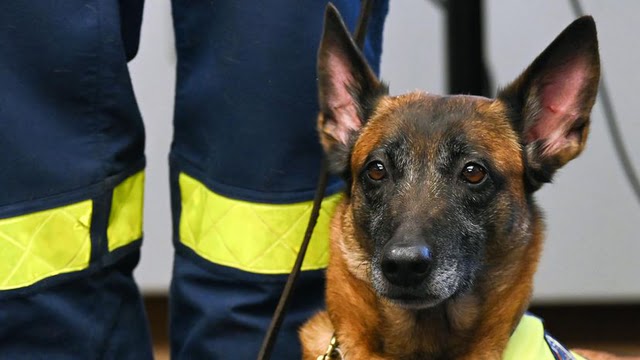Quck answer
Search-and-rescue dogs are specially trained canines that help locate missing persons in various environments, such as natural disasters, wilderness, and urban settings. These dogs have a keen sense of smell, which they use to detect human scent and locate people who are lost or trapped. Search-and-rescue dogs are typically trained in specific areas, such as tracking, air scenting, and cadaver detection. They work alongside their handlers, who provide guidance and support during the search. These dogs are highly valued members of search-and-rescue teams and have saved countless lives over the years.
Animal Information

Rescue dog Kaskia is one of many canines assisting in search-and-rescue operations following a devastating earthquake in Turkey. Ann-Marie Utz/picture alliance via Getty Images
Since a massive 7.8-magnitude earthquake struck Turkey near the town of Gaziantep early on Monday morning, February 6, 2023, thousands of individuals in Turkey and Syria have lost their lives, and tens of thousands more are now homeless or injured.
Many nations, including the United States, are contributing aid to assist with rescue efforts. The U.S. Transportation Command (USTRANSCOM) and the U.S. Agency for International Development (USAID) are sending two Urban Search and Rescue (USAR) teams, along with 161 USAR personnel, 170,000 pounds of equipment, and twelve search-and-rescue dogs to assist in the extraction of survivors from the rubble.
Search-and-rescue teams are made up of structural engineers, medical professionals, logistics personnel, and technical search experts.
Search-and-rescue dogs are valuable assets in rescue operations such as this, where time is of the essence, because they can detect the scent of humans who may be buried. These highly trained dogs are skilled in finding human scents, and the U.S. is not the only country sending canines to assist in rescue efforts in Turkey and Syria. Mexico sent sixteen dogs, and Croatia, the Czech Republic, Germany, Greece, Libya, Poland, Switzerland, and the United Kingdom are also sending dogs with their handlers.
So, what is the role of a search-and-rescue dog and its handler, and how are these dogs trained to detect human scents and alert their handlers to their location?
FAQ
1. What are search-and-rescue dogs?
Search-and-rescue dogs are specially trained canines that assist in finding missing people in various situations. They are highly skilled in tracking scents and following trails in different environments, from urban areas to wilderness and disaster zones.
2. How are search-and-rescue dogs trained?
Search-and-rescue dogs undergo extensive training, which can take up to two years. They learn to detect and follow specific scents through various exercises and simulations. They also learn to work with their handlers and other members of a search-and-rescue team.
3. What breeds are commonly used for search-and-rescue work?
Some of the most common breeds used for search-and-rescue work include German Shepherds, Labrador Retrievers, and Belgian Malinois. These breeds are known for their intelligence, loyalty, and strong work ethic. However, other breeds and mixed breeds can also be trained for search-and-rescue work.
4. What types of search-and-rescue missions do dogs participate in?
Search-and-rescue dogs can assist in a variety of missions, including tracking missing persons, locating survivors in disaster zones, and detecting drugs or explosives. They can also help with avalanche and water rescues.
5. How do search-and-rescue dogs communicate with their handlers?
Search-and-rescue dogs communicate with their handlers through body language, barks, and other vocalizations. Handlers are trained to understand their dog’s behavior and cues and to respond accordingly.
6. What equipment do search-and-rescue dogs use?
Search-and-rescue dogs typically wear a harness or vest that identifies them as part of a search-and-rescue team. They may also wear protective gear, such as boots or goggles, depending on the mission. Their handlers use a variety of tools, such as GPS devices and radios, to communicate and track the dog’s movements.
7. How do search-and-rescue dogs stay safe during missions?
Search-and-rescue dogs undergo rigorous training to prepare them for various situations and hazards. Their handlers also take steps to ensure their safety, such as using protective gear and monitoring their health and hydration levels.
8. How can I get involved in search-and-rescue work with my dog?
To get involved in search-and-rescue work with your dog, you will need to undergo training and certification through a recognized organization. You will also need to meet certain requirements, such as having a well-trained dog with strong search-and-rescue abilities and being physically fit and able to handle the demands of search-and-rescue work.
9. Can search-and-rescue dogs retire?
Yes, search-and-rescue dogs can retire from their work once they reach a certain age or when they are no longer physically able to perform their duties. Many retired search-and-rescue dogs continue to live with their handlers or are adopted by loving families.
10. How can I support search-and-rescue dog teams?
You can support search-and-rescue dog teams by donating to organizations that train and deploy these dogs, volunteering your time and resources, and spreading awareness about the important work they do. You can also help by following safety guidelines and being mindful of your surroundings when participating in outdoor activities.





Leave a Reply